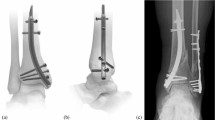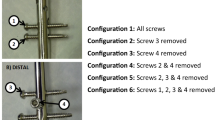Abstract
Introduction
A tibial nail with fixed-angle locking screws intends to combine the advantages of angular stability and intramedullary stabilization in extraarticular proximal tibial fractures. The goal of this study is to analyze if the angle stable tibial nail (ASN) is biomechanically more stable than an established conventional standard nail (CN).
Methods
Two types of nails were compared on a series of ten matched pairs of human tibiae. After setting a proximal tibial defect fracture, the intramedullary stabilized tibiae were axially loaded starting from 100 N increasing in steps of 100 N after every 200 cycles until failure was reached. Failure was defined as deformation of the fracture gap, fracturing of the bone or the implant.
Results
The two types of nails showed no significant difference in terms of maximum tolerated load, maximum cycles repeated or axial deformation of the bone–implant construct. The mean load at failure was 1,365 N for the CN and 1,195 N for the ASN. The mean axial deformation for conventional (19 mm) and angle stable nail (21 mm) did not differ significantly. Slightly less nail or screw loosening was noticed with the fixed-angle nail.
Conclusion
No significant difference in stability between the two compared implants could be demonstrated. A trend could be shown indicating that the rate of nail loosening in the proximal osteotomized part of the bone was lower for the angle stable nail. This trend, however, could not be substantiated statistically.





Similar content being viewed by others
References
Beardi J, Hessmann M, Hansen M, Rommens PM (2008) Operative treatment of tibial shaft fractures: a comparison of different methods of primary stabilisation. Arch Orthop Trauma Surg 128:709–715
Court-Brown CM, McBirnie J (1995) The epidemiology of tibial fractures. J Bone Joint Surg Br 77:417–421
Tytherleigh-Strong GM, Keating JF, Court-Brown CM (1997) Extra-articular fractures of the proximal tibial diaphysis: their epidemiology, management and outcome. J R Coll Surg Edinb 42:334–338
Bach AW, Hansen ST Jr (1989) Plates versus external fixation in severe open tibial shaft fractures. A randomized trial. Clin Orthop Relat Res 89–94
Boldin C, Fankhauser F, Hofer HP, Szyszkowitz R (2006) Three-year results of proximal tibia fractures treated with the LISS. Clin Orthop Relat Res 445:222–229
Cole PA, Zlowodzki M, Kregor PJ (2004) Treatment of proximal tibia fractures using the less invasive stabilization system: surgical experience and early clinical results in 77 fractures. J Orthop Trauma 18:528–535
Krettek C, Gerich T, Miclau T (2001) A minimally invasive medial approach for proximal tibial fractures. Injury 32(Suppl 1):SA4–SA13
Buehler KC, Green J, Woll TS, Duwelius PJ (1997) A technique for intramedullary nailing of proximal third tibia fractures. J Orthop Trauma 11:218–223
Hansen M, Mehler D, Hessmann MH, Blum J, Rommens PM (2007) Intramedullary stabilization of extraarticular proximal tibial fractures: a biomechanical comparison of intramedullary and extramedullary implants including a new proximal tibia nail (PTN). J Orthop Trauma 21:701–709
Laflamme GY, Heimlich D, Stephen D, Kreder HJ, Whyne CM (2003) Proximal tibial fracture stability with intramedullary nail fixation using oblique interlocking screws. J Orthop Trauma 17:496–502
Lang GJ, Cohen BE, Bosse MJ, Kellam JF (1995) Proximal third tibial shaft fractures. Should they be nailed? Clin Orthop Relat Res 64–74
Nork SE, Barei DP, Schildhauer TA, Agel J, Holt SK, Schrick JL, Sangeorzan BJ (2006) Intramedullary nailing of proximal quarter tibial fractures. J Orthop Trauma 20:523–528
Gueorguiev B, Wahnert D, Albrecht D, Ockert B, Windolf M, Schwieger K (2011) Effect on dynamic mechanical stability and interfragmentary movement of angle-stable locking of intramedullary nails in unstable distal tibia fractures: a biomechanical study. J Trauma 70:358–365
Horn J, Linke B, Höntzsch D, Gueorguiev B, Schwieger K (2009) Angle stable interlocking screws improve construct stability of intramedullary nailing of distal tibia fractures: a biomechanical study. Injury 40:767–771
Zlowodzki M, Williamson S, Cole PA, Zardiackas LD, Kregor PJ (2004) Biomechanical evaluation of the less invasive stabilization system, angled blade plate, and retrograde intramedullary nail for the internal fixation of distal femur fractures. J Orthop Trauma 18:494–502
Muller MN S, Koch P, Schatzker J (1990) The comprehensive classification of fractures of long bones. Springer, Berlin
Arima J, Whiteside LA, McCarthy DS, White SE (1995) Femoral rotational alignment, based on the anteroposterior axis, in total knee arthroplasty in a valgus knee: a technical note. J Bone Joint Surg Am 77:1331–1334
Krettek C, Stephan C, Schandelmaier P, Richter M, Pape HC, Miclau T (1999) The use of Poller screws as blocking screws in stabilising tibial fractures treated with small diameter intramedullary nails. J Bone Joint Surg Br 81:963–968
Hansen M, Mehler D, Voltmer W, Rommens PM (2002) The extraarticular proximal tibial fractures. Unfallchirurg 105:858–872
Lindvall E, Sanders R, Dipasquale T, Herscovici D, Haidukewych G, Sagi C (2009) Intramedullary nailing versus percutaneous locked plating of extra-articular proximal tibial fractures: comparison of 56 cases. J Orthop Trauma 23:485–492
Mueller CA, Eingartner C, Schreitmueller E, Rupp S, Goldhahn J, Schuler F, Weise K, Pfister U, Suedkamp NP (2005) Primary stability of various forms of osteosynthesis in the treatment of fractures of the proximal tibia. J Bone Joint Surg Br 87:426–432
Bono CM, Levine RG, Rao JP, Behrens FF (2001) Nonarticular proximal tibia fractures: treatment options and decision making. J Am Acad Orthop Surg 9:176–186
Bhattacharyya T, Seng K, Nassif NA, Freedman I (2006) Knee pain after tibial nailing: the role of nail prominence. Clin Orthop Relat Res 449:303–307
Safran O, Liebergall M, Segal D, Mosheiff R (2001) Proximal tibial fractures—should we nail them? Am J Orthop 30:681–684
Sayana MK, Davis BJ, Kapoor B, Rahmatalla A, Maffulli N (2006) Fracture strain and stability with additional locking screws in intramedullary nailing: a biomechanical study. J Trauma 60:1053–1057
Gollwitzer H, Karampour K, Hauschild M, Diehl P, Busch R, Mittelmeier W (2004) Biomechanical investigation of the primary stability of intramedullary compression nails in the proximal tibia: experimental study using interlocking screws in cryopreserved human tibias. J Orthop Sci 9:22–28
Wolinsky PR, Dennis D, Crist BD, Curtiss S, Hazelwood SJ (2011) The biomechanics of varied proximal locking screw configurations in a synthetic model of proximal third tibial fracture fixation. J Orthop Trauma 25:175–179
Conflict of interest
The authors declare that they have no conflict of interest.
Author information
Authors and Affiliations
Corresponding author
Rights and permissions
About this article
Cite this article
Thelen, S., Betsch, M., Grassmann, JP. et al. Angle stable locking nails versus conventionally locked intramedullary nails in proximal tibial shaft fractures: a biomechanical study. Arch Orthop Trauma Surg 132, 57–63 (2012). https://doi.org/10.1007/s00402-011-1380-8
Received:
Published:
Issue Date:
DOI: https://doi.org/10.1007/s00402-011-1380-8




